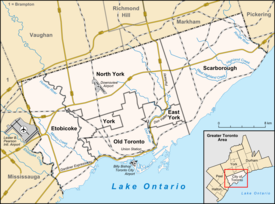
The Don River is a watercourse in southern Ontario, that empties into Lake Ontario, at Toronto Harbour. Its mouth was just east of the street grid of the town of York, Upper Canada, the municipality that evolved into Toronto, Ontario. The Don is one of the major watercourses draining Toronto that have headwaters in the Oak Ridges Moraine.
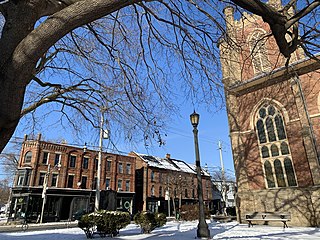
Corktown is an older residential neighbourhood in downtown Toronto, Ontario, Canada. The neighbourhood is south of Shuter Street, north of the Gardiner Expressway, east of Parliament Street, and west of Don River to the east. Corktown contains many vacated industrial buildings, some now used for movie production, and others repurposed for studios and shops. The West Don Lands development is in the south-east corner of this area.

The Toronto waterfront is the lakeshore of Lake Ontario in the city of Toronto, Ontario, Canada. It spans 46 kilometres between the mouth of Etobicoke Creek in the west and the Rouge River in the east.

Toronto Harbour or Toronto Bay is a bay on the north shore of Lake Ontario, in Toronto, Ontario, Canada. It is a natural harbour, protected from Lake Ontario waves by the Toronto Islands. Today, the harbour is used primarily for recreational boating, including personal vessels and pleasure boats providing scenic or party cruises. Ferries travel from docks on the mainland to the Islands, and cargo ships deliver aggregates and raw sugar to industries located in the harbour. Historically, the harbour has been used for military vessels, passenger traffic and cargo traffic. Waterfront uses include residential, recreational, cultural, commercial and industrial sites.

Front Street is an east–west road in downtown Toronto, Ontario, Canada. First laid out in 1796, the street is one of the original streets of the Town of York. The street was laid out along the shoreline of Lake Ontario as it existed during that time. It remains an important street, with many important uses located along it, including the St. Lawrence Market, Meridian Hall, Union Station and the Metro Toronto Convention Centre. The eastern section of Front Street, in the West Don Lands, east of Cherry Street, is being rebuilt as a broad tree-lined boulevard, intended to be the pedestrian-friendly commercial spine of the new neighbourhood.
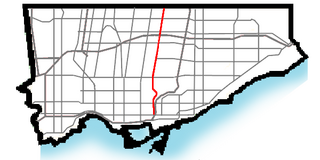
Bayview Avenue is a major north–south route in the Greater Toronto Area of Ontario. North of Toronto, in York Region, Bayview is designated as York Regional Road 34.

The Distillery District is a commercial and residential district in Toronto, Ontario, Canada, east of downtown, which contains numerous cafés, restaurants, and shops housed within heritage buildings of the former Gooderham and Worts Distillery. The 13 acres (5.3 ha) district comprises more than forty heritage buildings and ten streets, and is the largest collection of Victorian-era industrial architecture in North America.

Downtown Toronto is the main central business district of Toronto, Ontario, Canada. Located entirely within the district of Old Toronto, it is approximately 16.6 square kilometres in area, bounded by Bloor Street to the northeast and Dupont Street to the northwest, Lake Ontario to the south, the Don Valley to the east, and Bathurst Street to the west. It is also the home of the municipal government of Toronto and the Government of Ontario.

The Port Lands of Toronto, Ontario, Canada are an industrial and recreational neighbourhood located about 5 kilometres south-east of downtown, located on the former Don River delta and most of Ashbridge's Bay.
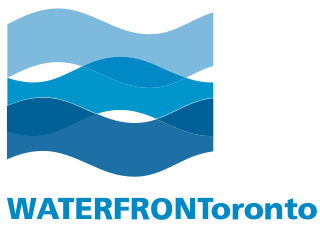
Waterfront Toronto is an organization that oversees revitalization projects along the Toronto waterfront. Established in 2001 as a public–public partnership between the City of Toronto, Province of Ontario and Government of Canada, the organization is administering several blocks of land redevelopment projects surrounding Toronto Harbour and various other initiatives to promote the revitalization of the area, including public transit, housing developments, brownfield rehabilitation, possible removal of the Gardiner Expressway in the area, the Martin Goodman Trail and lakeshore improvements, and naturalization of the Don River. Actual development of the projects is done by other entities, primarily private corporations. The projects include a series of wavedeck walkways and gathering places designed by West 8 and DTAH.
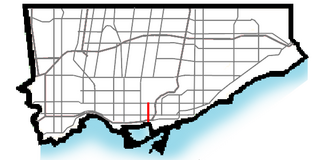
Parliament Street is a north-south street in the eastern part of downtown Toronto, Ontario, Canada. The street runs from Bloor Street to Queens Quay and is the first major street west of the Don River.
East Bayfront LRT is a proposed Toronto streetcar line that would serve the East Bayfront and Port Lands areas in Toronto, Ontario, Canada. It would run from Union station under Bay Street and along Queens Quay and Cherry Street to a new Polson Loop near the intersection of Cherry and Polson Streets in the Port Lands. It would complement the existing 509 Harbourfront service which connects Union Station to Queens Quay west of Bay Street. Longer term plans are to extend the East Bayfront line from Cherry and Commissioners Streets to the proposed East Harbour station along the planned Ontario Line.
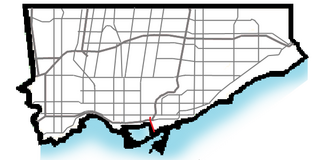
Cherry Street is a north-south roadway in Toronto, Ontario, Canada. Cherry Street is carried over the waterways of the Port Lands by Toronto's only two lift bridges. A smaller one where it crosses the Keating Channel and a larger one where it crosses the channel to the turning basin. Its northern terminus is at Eastern Avenue. A co-linear street, named Sumach St., continues north. It crosses Front St., Mill St., Lake Shore Boulevard, Commissioners Street and Unwin Ave. After crossing Unwin, it continues another 200 metres south to Cherry Beach, where it ends in a roundabout.
Corktown Common is a park in the south eastern portion of the West Don Lands neighbourhood in Toronto, Ontario, Canada which opened in 2013. It borders the Don River to the east. It was built on remediated industrial lands to be the centrepiece of a new emerging neighbourhood in downtown Toronto. It also provides a barrier to flooding from the Don River.
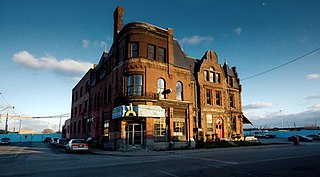
The Cherry Street Hotel is an 1859 heritage building in Toronto, Ontario, Canada. It is located on the southeast corner of Front Street and Cherry Street, in the West Don Lands neighbourhood. The structure was originally the Palace Street School, which closed in 1887. The building was converted into a hotel, and later became an industrial building housing small industry. In the 1960s, the Canary Restaurant opened. The building became a type of incubator, renting small spaces for artists and small businesses. The restaurant closed after the area around the building was demolished for the new West Don Lands community. The building has been integrated into the new community and its facade retained and restored. Its next use has not been announced.

The Canadian National Railway Police Building, also known as the Canadian National Railways Office Building is a 1923 heritage building in Toronto, Ontario, Canada. It is located at the corner of Front Street and Cherry Street in the West Don Lands neighbourhood. The building served as the Toronto headquarters for the Canadian National Railways (CNR) police. It is one of two preserved buildings on Cherry Street that weren't demolished to make way for a new housing development, the other being the Cherry Street Hotel, across the street on the southeast corner. On April 14, 2005, the City of Toronto Council approved the listing of the property on the City of Toronto Heritage Property Inventory.

The Canary District is a housing development in Toronto's West Don Lands mixed-use development. Six initial buildings initially served as the 2015 Pan American Games Athletes' Village for the 2015 Pan American Games. Those buildings were then finished and converted to private residences. Dozens of further buildings will be constructed for private residences, with Front Street lined with boutiques and restaurants.

The Athlete's village for the 2015 Pan American Games and 2015 Parapan American Games cost $735 million CAD and had the capacity to hold up to 7,200 athletes and officials. After the games the village was converted to 746 market priced condos, 41 market-priced town homes, 250 affordable-rent apartments, 257 student dormitory units for George Brown College, office and retail units, and a YMCA recreation centre. The Athlete's Village was located in the West Don Lands along Front Street between Bayview Avenue and Cherry Street in Toronto. The development was certified LEED Gold. Five satellite villages were also used to house athletes that were competing in venues far from the main village.

Villiers Island is a 22-hectare (54-acre) area in Toronto's Port Lands being made into an island as part of Waterfront Toronto's Port Lands Flood Protection Project. To prevent flooding from the Don River, a channel is being created to extend the river south and then west into Toronto Harbour providing another outlet and a more natural mouth for the Don River. The new channel effectively creates the island, which is also bounded by the Keating Channel and Toronto Harbour. Mixed-use residential development is planned for Villiers Island.
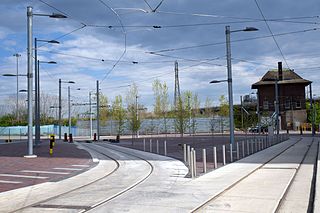
Distillery Loop is a streetcar loop in the Toronto streetcar system in Toronto, Ontario, Canada that lies at the south end of the Cherry Street branch – originally dubbed the Cherry Street streetcar line – that runs from a streetcar junction on King Street East south along Sumach and Cherry Streets. The loop opened in June 2016 and is some of the newer streetcar infrastructure in the city. The Cherry Street branch is currently served by the 504A King streetcar route which has its eastern terminus at Distillery Loop.


